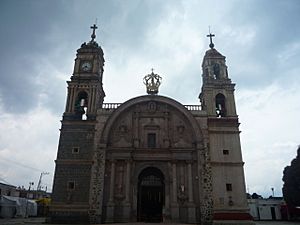Guadalupe Yancuictlalpan facts for kids
Quick facts for kids
Gualupita Yancuictlalpan
|
|
|---|---|
| Guadalupe Yancuictlalpan | |

Church of our Lady of Guadalupe
|
|
| Country | |
| State | State of Mexico |
| Municipality | Tianguistenco, State of Mexico |
| Elevation
(of seat)
|
2,600 m (8,500 ft) |
| Population
(2000)
|
|
| • Total | 6,385 |
| Time zone | UTC-6 (CST) |
| Website | site |
Guadalupe Yancuictlalpan, often called Gualupita, is a small town in Mexico State. It's part of the Tianguistenco area. The name Yancuictlalpan comes from the Nahuatl language. It means "new land."
This town is about 60 kilometers from Mexico City. It's also 30 kilometers from Toluca. Gualupita is well-known for its beautiful wool crafts. Local artists make knitted and woven items. Every weekend, they hold a market. You can find these textile crafts on the main street.
A Look Back in Time
The main church in Gualupita has a long history. Its construction started in 1679. It took many years to build. The church was finally finished in 1789. You can see these dates on the South Tower of the temple.
Who Lives Here?
The number of people living in Gualupita has grown. In 1990, there were 2,812 residents. By the year 2000, the population had increased to 6,385 people. This means Gualupita's population was about 10.9% of the total people in the Tianguistenco municipality.
How People Make a Living
Most of the money in Gualupita comes from textiles. People create and sell both handmade and factory-made clothes. Farming and raising animals are not very common activities here.
On Saturdays, the community organizes a special market called a "tianguis". At this market, you can buy fresh fruits and vegetables. On Sundays, the local people sell their handmade and industrial clothing.
Amazing Handicrafts
The people of Gualupita are famous for their woven items. They use old-style wooden looms. Many of these looms have been passed down through families for generations.
The art of making textiles here is very old. It dates back to at least 1472. Back then, people used fibers from the maguey plant. After the Spanish arrived, they started mixing these fibers with wool. Today, local artisans create many beautiful items. These include zarapes, mañanitas, and sweaters.
See also
 In Spanish: Guadalupe Yancuictlalpan para niños
In Spanish: Guadalupe Yancuictlalpan para niños

